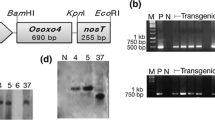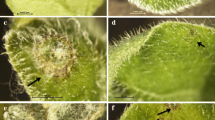Summary
Potato (cv. Bintje) was transformed with a gene encoding an oxalate oxidase from wheat under the control of the CaMV35S promoter. Transgenic potato plants produced high constitutive levels of H2O2 as visualized by 4-chloro-l-naphtol staining. The resistance of these plants was tested againstPhytophthora infestans. An increased level of resistance to the disease was marked by a reduced number of lesions as well as by a decreased number of sporangia formed per lesion. In addition, oxalate oxidase overexpressing plants also exhibited improved resistance toStreptomyces reticuliscabiei, the causal agent of netted scab. Increased expression of oxalate oxidase had no effect on the interaction withErwinia carotovora. These experiments show that overexpression of oxalate oxidase represents a potentially interesting approach for protection of potato to pathogens.
Similar content being viewed by others
References
Barker, H., B. Reavy, K.D. Webster, C.A. Jolly, A. Kumar & M.A. Mayo, 1993. Relationship between transcript production and virus-resistance in transgenic tobacco expressing the potato leafroll virus coat protein gene.Plant Cell Reports 13: 54–58.
Barker, H., K.D. Webster, C.A. Jolly, B. Reavy, A. Kumar & M.A. Mayo, 1994. Enhancement of resistance to potato leafroll virus multiplication in potato by combining the effects of host genes and transgenes.Molecular Plant-Microbe Interactions 7: 528–530.
Bevan, M., 1984. Binary Agrobacterium vectors for plant transformation.Nucleic Acids Research 12:8711–8721.
Bouchek-Mechiche, K., C. Pasco, D. Andrivon & B. Jouan, 2000. Differences in host range, pathogenicity to potato cultivars and response to soil temperature among Streptomyces species causing common and netted scab in France.Plant Pathology 49: 3–10.
Brisson, L.F., R. Tenhaken & C.J. Lamb, 1994. Function of oxidative cross-linking of cell wall structural proteins in plant disease resistance.Plant Cell 6: 1703–1712.
Coquoz, J.L., A.J. Buchala, P. Meuwly & J.P. Métraux, 1995. Arachidonic-acid induces local but not systemic synthesis of salicylic-acid and confers systemic resistance in potato plants toPhytophthora infestons andAlternaria solani.Phytopathology 85: 1219–1224.
Donaldson, P.A., T. Anderson, B.G. Lane, A.L. Davidson & D.H. Simmonds, 2001. Soybean plants expressing an active oligomeric oxalate oxidase from the wheat gf-2.8 (germin) gene are resistant to the oxalate-secreting pathogen Sclerotina sclerotioram.Physiological and Molecular Plant Pathology 59: 297–307.
Dumas, B., G. Freyssinet & K.E. Pallett, 1995. Tissue-specific expression of germin-like oxalate oxidase during development and fungal infection of barley seedlings.Plant Physiology 107: 1091–1096.
Dutton, M.V. & C.S. Evans, 1996. Oxalate production by fungi: Its role in pathogenicity and ecology in the soil environment.Canadian Journal of Microbiology 42: 881–895.
Goto, M., 1992. Fundamentals of bacterial plant pathology. Academic Press. Kuc, J., 2001. Concepts and direction of induced systemic resistance in plants and its application.European Journal of Plant Pathology 107: 7–12.
Lamb, C.J., J.A. Ryals, E.R. Ward & R.A. Dixon, 1992. Emerging strategies for enhancing crop resistance to microbial pathogens.Biotechnology 10: 1436–1445.
Lane, B.G., 2002. Oxalate, germins, and higher-plant pathogens.IUBMB Life 53: 67–75.
Lane, B.G., A.C. Cuming, J. Fregeau, N.C. Carpita, W.J. Hurkman, F. Bernier, E. Dratewkakos & T.D. Kennedy, 1992. Germin Isoforms Are Discrete Temporal Markers of Wheat Development -Pseudogermin Is a Uniquely Thermostable Water-Soluble Oligomeric Protein in Ungerminated Embryos and Like Germin in Germinated Embryos, It Is Incorporated into Cell-Walls.European Journal of Biochemistry 209: 961–969.
Lane, B.G., J.M. Dunwell, J.A. Ray, M.R. Schmitt & A.C. Cuming, 1993. Germin, a protein marker of early plant development, is an oxalate oxidase.Journal of Biological Chemistry 268: 12239–12242.
Levine, A., R. Tenhaken, R.A. Dixon & C.J. Lamb, 1994. H2O2 from the oxidative burst orchestrates the plant hypersensitive disease resistance response.Cell 79: 583–593.
Mehdy, M.C., Y.K. Sharma, K. Sathasivan & N.W. Bays, 1996. The role of activated oxygen species in plant disease resistance.Physiologia Plantarum 98: 365–374.
Miguel, E., C. Poza-Carrion, E. Lopez-Solanilla, I. Aguilar, A. Llama-Palacios, F. Garcia-Olmedo & P. Rodriguez-Palenzuela, 2000. Evidence against a direct antimicrobial role of H2O2 in the infection of plants by Erwinia chrysanthemi.Molecular Plant Microbe Interactions 13: 421–429.
Odell, J.T., F. Nagy & N.H. Chua, 1985. Identification of DNA sequences required for activity of the cauliflower mosaic virus 35S promoter.Nature 313: 810–812.
Oerke, E.C. & H.W. Dehne, 1997. Global crop production and the efficacy of crop protection-Current situation and future trends.European Journal of Plant Pathology 103: 203–215.
Ooms, G., A. Bakker, L. Molendijk, G.J. Wullems, M.P. Gordon, E.W. Nester & R.A. Schilperoort, 1982. T-DNA organization in homogeneous and heterogeneous octopinetype crown gall tissues of Nicotiana tabacum.Cell 30: 589–597.
Ouchi, S., H. Toyoda, S. Utsumi, H. Hashimoto & T. Hadama, 1983. A promising strategy for the control of fungal disease by the use of toxin-degrading microbes. In: A. Graniti (Ed.), Phytotoxins and Plant Pathogenesis. NATO ASI Series, Springer, Heidelberg, pp. 301–315.
Pignard, A., B. Grezes-Besset, R. Grison & M. Schneider, 1994. Use of a DNA sequence coding for an oxalic acid degrading protein as a selection gene. In: WO 94/13790.
Sambrook, J., E.F. Fritsch & T. Maniatis, 1989. Molecular cloning: a laboratory manual. Cold Spring Harbor Laboratory Press, Cold Spring Harbor.
Smirnoff, N. & J.E. Pallanca, 1996. Ascorbate metabolism in relation to oxidative stress.Bio-chemical Society Transactions 24: 472–478.
Tenhaken, R., A. Levine, L.F. Brisson, R.A. Dixon & C.J. Lamb, 1995. Function of the oxidative burst in hypersensitive disease resistance.Proceedings of the National Academy of Sciences of the United States of America 92: 4158–4163.
Vallelian-Bindschedler, L., P. Schweizer, E. Mosinger & J.P. Métraux, 1998. Heat-induced resistance in barley to powdery mildew (Blumeria graminis f.sp. hordei) is associated with a burst of active oxygen species.Physiological and Molecular Plant Pathology 52: 185–199.
Wu, G.S., B.J. Shortt, E.B. Lawrence, J. Leon, K.C. Fitzsimmons, E.B. Levine, I. Raskin & D.M. Shah, 1997. Activation of host defense mechanisms by elevated production of H2O2 in transgenic plants.Plant Physiology 115: 427–435.
Wu, G.S., B.J. Shortt, E.B. Lawrence, E.B. Levine, K.C. Fitzsimmons & D.M. Shah, 1995. Disease resistance conferred by expression of a gene encoding H2O2-generating glucose oxidase in transgenic potato plants.Plant Cell 7: 1357–1368.
Author information
Authors and Affiliations
Rights and permissions
About this article
Cite this article
Schneider, M., Droz, E., Malnoë, P. et al. Transgenic potato plants expressing oxalate oxidase have increased resistance to oomycete and bacterial pathogens. Potato Res 45, 177–185 (2002). https://doi.org/10.1007/BF02736113
Accepted:
Issue Date:
DOI: https://doi.org/10.1007/BF02736113




